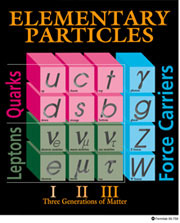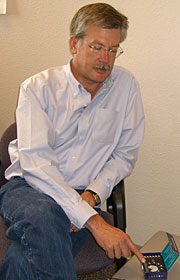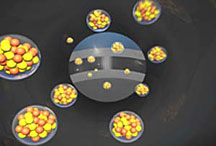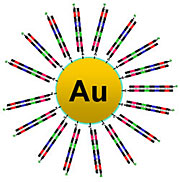| Research
|
|
|||||||||||||||||||||||||
|
Check out the Office of Science's new Website.
|
Exotic relatives of protons
|
 |
| Six quarks—up, down, strange, charm, bottom and top—are the building blocks of matter. Protons and neutrons are made of up and down quarks, held together by the strong nuclear force. The CDF experiment has discovered exotic relatives of the proton and neutron, particles that include a bottom quark. |
“These particles, named Sigma-sub-b [∑b], are like rare jewels that we mined out of our data,” said Jacobo Konigsberg, University of Florida, a spokesperson for the CDF collaboration. “Piece by piece, we are developing a better picture of how matter is built out of quarks. We learn more about the subatomic forces that hold quarks together and tear them apart. Our discovery helps complete the ‘periodic table of baryons.'”
Baryons (derived from the Greek word “barys”, meaning “heavy”) are particles that contain three quarks, the most fundamental building blocks of matter. The CDF collaboration discovered two types of Sigma-sub-b particles, each one about six times heavier than a proton.
There are six different types of quarks: up, down, strange, charm, bottom and top (u, d, s, c, b and t). The two types of baryons discovered by the CDF experiment are made of two up quarks and one bottom quark (u-u-b), and two down quarks and a bottom quark (d-d-b). For comparison, protons are u-u-d combinations, while neutrons are d-d-u.
Utilizing Fermilab's Tevatron collider physicists can recreate the conditions present in the early formation of the universe, reproducing the exotic matter that was abundant in the moments after the big bang. While the matter around us is composed of only up and down quarks, exotic matter contains other quarks as well. The new particles discovered by CDF are extremely short-lived and decay within a tiny fraction of a second.
The Tevatron collider at Fermilab accelerates protons and antiprotons close to the speed of light and makes them collide. In the collisions, energy transforms into mass, according to Einstein's famous equation E=mc2. To beat the low odds of producing bottom quarks—which in turn transform into the Sigma-sub-b according to the laws of quantum physics—scientists take advantage of the billions of collisions produced by the Tevatron each second.
"It's amazing that scientists can build a particle accelerator that produces this many collisions, and equally amazing that the CDF collaboration was able to develop a particle detector that can measure them all," said CDF cospokesperson Rob Roser, of Fermilab. “We are confident that our data hold the secret to even more discoveries that we will find with time.”Submitted by DOE's
Fermi National
Accelerator Laboratory



